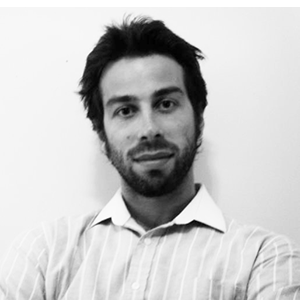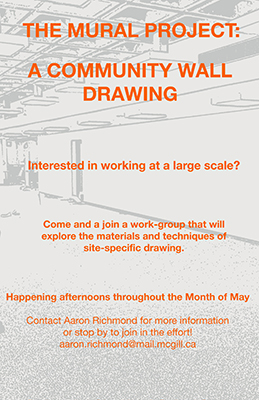
Aaron Richmond is a Montreal-based artist whose practice explores the psychological and semiotic capacities of tectonic space. Using a broad range of material and conceptual parameters, his work seeks to address both the individual and the collective in their various capacities for working, making and building.
Aaron is the recipient of awards which include, most recently, the 2016 Robert Motherwell Fellowship and the 2015 Milton and Sally Avery Fellowship, both awarded through the Fine Arts Work Center in Provincetown, MA. He holds a Masters of Philosophy from the University of Cambridge, and a Master’s of Fine Arts from the Hoffberger School at the Maryland Institute College of Art.
As an AiR at McGill’s Faculty of Education, Aaron will combine his experience as an artist and educator, exploring how the act of drawing can function as a mode of thinking within the context of education. He intends to develop a multi-layered program in which the viabilities of artistic practice are made accessible to faculty, students, and their broader communities.
Learn more about Aaron’s work at: aarichmond.com




Photos by Aaron Richmond
Music in the Atrium
Students from Music Education Class work with Artists-in-Residence Aaron Richmond and Victoria Stanton
Overview of the Project
This was a Music-Education dual degree class. We went into the class on November 24th, 2017 and talked about “constructivist” approaches to art making, i.e. working with basic elements, and experimenting with spatial parameters. We gave them all a basic layout plan of the atrium space and asked them to come to our second meeting with instruments in hand. They were also meant to draw a “propositional sketch” which would outline an ensemble of 3-4 instruments within the space of the atrium.
In the atrium, we did a number of warm up exercises in which they “attuned” their instruments and voices to the material conditions within the environment. We explored the properties of “rhythm” as a sonic texture ( musical consistency) rather than a strictly regulated meter. The students were asked to sound out for one another in the space, and to develop conversations within a musical environment that would allow for other conversations to enter.
In the second part of the exercise, we took three different ensemble concepts, and used them as a prompt for three different soundscapes.In between each ensemble, the group came together and discussed the previous exercise and made slight adjustments to our working methods. For example, we banned ourselves from the piano which we considered too much of a “compositional” (as opposed to constructivist) sound machine. We also limited ourselves from speaking to one another in the process. The last piece we did we moved into the stairwell and made the logic of walking up and down the stairs our central musical prompt.
Our emphasis was on what Victoria and Aaron were thinking of as a dual opening – one towards the pre-existing musicality of the space, and one towards the potential musicality of others who might want to enter. This was a very special class – and the teacher Lisa Lorenzino, to her credit, really had the group primed for this kind of camaraderie.
The Mural Project: A Community Wall Drawing
A work group that explored the materials and techniques of site-specific drawing.
Participants worked together, exploring:
- How to work with architectural parameters
- Choosing the right materials
- Developing a formal vocabulary
- Drawing and painting on a large-scale
